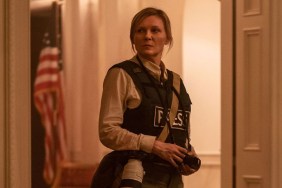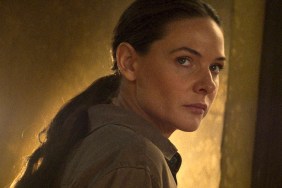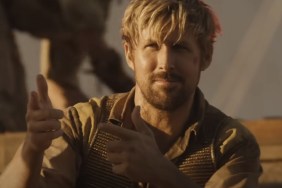
I first saw The Artist at the Cannes Film Festival earlier this year (my review here) and before it even had its first screening it was snatched up for distribution by the Weinstein Co. and there was a buzz in the air. A black-and-white film in this day and age was one thing, but a black-and-white silent film in the age of CG, 3D and Blu-ray was unthinkable.
Yet, writer/director Michel Hazanavicius dared to prove a format most people only associate with their great grandparents can tell a story just as well as James Cameron can with performance capture 3D in Avatar… better in fact.
After its Cannes debut it hit the festival circuit, moving from Moscow to Athens and from Zurich to Leeds. Now it is set to hit theaters on November 25 and hopefully win over audiences just as it has done at the festivals, winning the audience award at several of them from the Hamptons to San Sebastian.
People are falling in love with the film’s lead characters, including George (Jean Dujardin), the silent actor too proud to try his hand at talking motion pictures and Peppy (Berenice Bejo), the actress who takes full advantage of the new developments in sound. But it’s also the lovable Uggy, George’s pet Jack Russell terrier, that has gained plenty of attention, if not declared by most as the “actor” that steals the show.
The Artist harkens back to the classic age of cinema, a fact I used to kick off my nearly 30 minute interview with Hazanavicius when his promotional tour brought him to Seattle for what I have no problem calling, one of my favorite interviews ever. I hope you enjoy it as much as I did as we not only talk about The Artist, and a couple of different story ideas he had for it, but his love for Charlie Chaplin, his surprising opinion of famed French filmmaker Jacques Tati, an even more surprising fact about his relationship with The Thin Man, his approach to making a silent film set in the ’20s and his thoughts on Uggy.
This is a long interview, but I hope you’ll stick with it through the end as I think you can gain a greater appreciation for not only the film and the work Michel put into it, but for the format in general.
Enjoy!
The curious thing about this film, for me, is — and I hope this doesn’t sound rude, because it’s not meant to be rude because I do like the film — but is the movie really that good or is it more of a reminder to people that movies can be made differently and still be that good?
Michel Hazanavicius (MH): I think you’re perfectly right, the movie is the movie, but there is something about the format. I think I respected the format, I don’t think I made a “fake” movie. The format, for a lot of people, is new and people were so sure that nobody could do a silent movie, a modern silent movie. It goes against what people think.
People think silent movies that are black-and-white are old and they [are confused]. They are old because the [silent movies they know were] made in the ’20s. After 80 years, a movie made in the ’20s is old, obviously, but the format itself is not old. It’s just a format. What surprises people is that the format could be used [and be effective] now.
Well, beyond the critics, you’re winning audiences over as the film has already taken home several audience awards on the film festival circuit.
MH: Often we’re out of competition so that’s the only award we can have. Maybe if we were competing [laughing] I don’t know… No, no, no… I’m joking. I don’t care about that, but it’s amazing to win the audience award with a silent, black-and-white movie.
So are you surprised by the film’s reception as much as people seem to be surprised a black-and-white silent film can be entertaining?
MH: Well, I would hope they would like it, but yeah… I don’t want to fake modesty and say, “Oh, yes, I’m very surprised people like my movie.” No, I did my best to make sure people like it, but in a way I feel — not like a crook — but I cheated a little bit. I almost thought the talkies arrived almost ten years too early.
I think Chaplin would agree with you.

MH: Yeah, that is true, but it was good for Chaplin because he had the power, genius and talent to continue, but he was the only one. Now he’s a god in the history of cinema, but people like Borzage, von Sternberg, King Vidor, John Ford, Raoul Walsh, those kind of directors, if those ten years were spent doing silent movies they would have produced some masterpieces. Because during the four or five last years of the silent era the movies were incredibly good, and the sophistication and narration of the directing is really good and better than a lot of movies that you can see now from a directing point of view.
So, what I did, I did the movie they could have done, except that it’s not just ten years, but 80 years of sophistication using music, camera movement, what we can do with actors and story. So, yeah, I cheated in a way, but that’s what making a movie is about.
So why make a silent film and when did you come up with the idea? What was the motivational factor?
MH: It’s amazing, because everyone wants to know why. To me, the main question was “How?” That was the question, but people want to know why.
Well there must have been a spark, something that encouraged the idea… right?
MH: Sure, actually it was a fantasy I had for many, many years. And I spoke to friends, producers and everyone and would say, “I would really love to make a silent movie.” Usually the answer was, “Yeah, sure, but what about the real movie you want to do now?” And I believed them. So the first person I had to convince was myself. Then I had two successes in France, the two spoof movies —
Yeah, I actually watched both of your OSS films over the weekend and loved them both and I do want to talk to you about those a bit later.
MH: Oh, great. Well, with two successes, suddenly people don’t talk to you the same way.

They start paying attention a little more.
MH: Exactly, and also even yourself, you don’t listen to yourself and your desires the same way. I felt self confident enough that now I was able to do it and convince people. Because it’s very difficult when you finish a movie, you have a lot of options and you have to pick one and say, “Okay, this is what I am going to spend two, or three, or four years of my life working on.” So I decided if I didn’t do it now I would never do it.
I met producer Thomas Langmann who was very courageous, supportive and very good to me and allowed me to do it, but at the beginning I had many options for the story. Actually, the opening sequence — with the spy — was an option [for what the whole film would be]. A fun, light, adventure, comedy movie and I wanted to make it an hour and ten minutes. Short, delightful and happy. The only thing was, I wanted to do a parallel between the story and it was supposed to take place in Georgia with the Russians and what’s going on now. That was the little trick.
Another option was to adapt The Invisible Man, which is very stupid because you can’t see and you can’t hear him, which would have been too difficult.
Ultimately, when I spoke to people, people needed justification. Always it was, “Yeah, but why do you want to do a silent movie?” And the answer, “Because I want to,” which really was the truth, was not enough.
So I decided to work on a story of a silent movie actor, which [would] make things easier for the audience, because it makes sense to watch a silent movie when the story is about a silent movie actor.
So it seems like the story process not only developed the story, but also helped you come up with a why of convincing people why they’re going to like it.
MH: Exactly, and I was very proud of the way I tried to make people accept watching a silent movie. It’s very complex, to start with that sequence and the torture and the hero is like, “I won’t say a word. I won’t speak.” And the audience wants him to speak, but then it’s an action sequence so they accept not having dialogue because it’s action and they’re used to it. There’s also music and the orchestra, so in a way it’s between [a silent film and a talkie] and then the movie ends, the music stops and there is the first real silence. You see George hear something, the people in the crowd are applauding but you don’t hear [the claping] and I think it’s there that the audience accepts it being a silent film.
When making the film, how much was shot on black-and-white? Did you use film?
MH: Yeah, I used color film after a lot of tests. We always say black-and-white, but actually it’s about the greys. So to have all the nuances of grey to be able to play with we shot in color and then in post we went to black-and-white.









